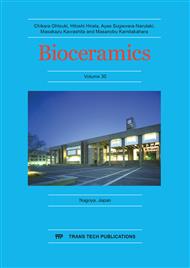[1]
L. Brandon-Peppas, J. O. Blanchette, Nanoparticle and Targeted Systems for Cancer Therapy, Adv. Drug Delivery Rev. 56 (2004) 1649–1659.
DOI: 10.1016/j.addr.2004.02.014
Google Scholar
[2]
Z. Yi, K. Wang, J. Tian, Y. Shu, J. Yang, W. Xiao, B. Li, X. Liao, Hierarchical porous hydroxyapatite fibers with a hollow structure as drug delivery carriers. Ceram Int. 42 (2016) 19079–19085.
DOI: 10.1016/j.ceramint.2016.09.067
Google Scholar
[3]
M. Okada, T. Furuzono, Hydroxylapatite nanoparticles: fabrication methods and medical applications. Sci. Technol. Adv. Mater. 13 (2012) 064103.
DOI: 10.1088/1468-6996/13/6/064103
Google Scholar
[4]
S. E. Kim, H. W. Choi, H. J. Lee, J. H. Chang, J. Choi, K. J. Kim, H. J. Lim, Y. J. Junc , S. C. Lee, Designing a highly bioactive 3D bone-regenerative scaffold by surface immobilization of nano-hydroxyapatite. J. Mater. Chem. 18 (2008) 4994–5001.
DOI: 10.1039/b810328c
Google Scholar
[5]
G. D. Venkatasubbu, S. Ramasamy, G.S. Avadhani, V. Ramakrishnan, J. Kumar, Surface modification and paclitaxel drug delivery of folic acid modified polyethylene glycol functionalized hydroxyapatite nanoparticles. Powder Technology 235 (2013).
DOI: 10.1016/j.powtec.2012.11.003
Google Scholar
[6]
M. Ming, L. Wei-Peng, C. Xiao-Feng, M. Ke-Ya, G. Yan-Chuan, Luminescent and Cytotoxic Characteristics of an Ellipsoidal and Microsized Europium (Eu)-doped Hydroxyapatite. J. Inorg. Mater. 31 (2016) 890–896.
DOI: 10.15541/jim20150662
Google Scholar
[7]
Y. Han, X. Wang, H. Dai, S. Li, Synthesis and luminescence of Eu3+ doped hydroxyapatite nanocrystallines: Effects of calcinations and Eu3+ content. J. Lumines. 135 (2013) 281–287.
DOI: 10.1016/j.jlumin.2012.09.029
Google Scholar
[8]
T. Kataoka, K. Shiba, M. Tagaya, Preparation of Europium(III)-Doped Hydroxyapatite Nanocrystals in the Presence of Cationic Surfactant, Colloids Interf. Sci. Commun. 13 (2016) 1−5.
DOI: 10.1016/j.colcom.2016.04.003
Google Scholar
[9]
D. Kozak, W. Anderson, R. Vogel, S. Chen, F. Antaw, M. Trau, Simultaneous Size and ζ‑Potential Measurements of Individual Nanoparticles in Dispersion Using Size-Tunable Pore Sensors, ACS Nano, 6 (8) (2012) 6990–6997.
DOI: 10.1021/nn3020322
Google Scholar
[10]
G. R. Willmott, R. Vogel, S. S. C. Yu, L. G. Groenewegen, G. S. Roberts, D. Kozak, W. Anderson, M. Trau, Use of tunable nanopore blockade rates to investigate colloidal dispersions, J. Phys.: Condens. Matter, 22 (2010) 454116.
DOI: 10.1088/0953-8984/22/45/454116
Google Scholar
[11]
M. Walker, T. Bednar, R. Lumry, Exciplex Studies. II. Indole and Indole Derivatives, J. Chem. Phys., 47 (1967) 1020–1028.
DOI: 10.1063/1.1711983
Google Scholar
[12]
M. Fenech, The role of folic acid and Vitamin B12 in genomic stability of human cells, Mutation Research/Fundamental and Molecular Mechanisms of Mutagenesis, 475 (2001) 57–67.
DOI: 10.1016/s0027-5107(01)00079-3
Google Scholar


